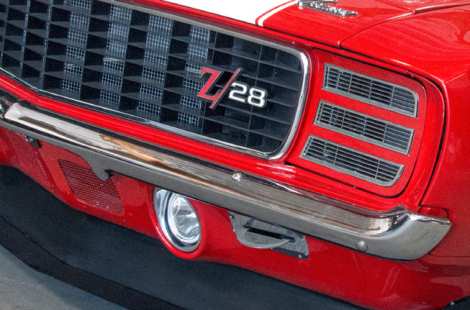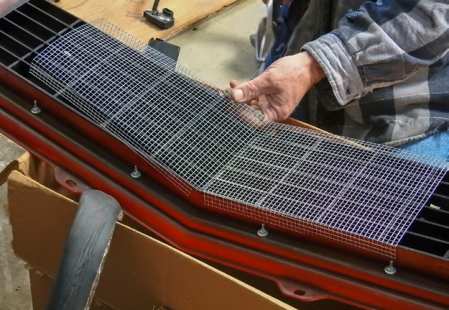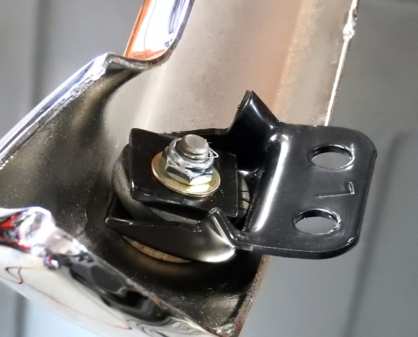GRILLE / FASCIA / BUMPER

The front end of a ’69 Rally Sport Camaro is arguably the best looking of all the late ’60s muscle cars. The designers at Chevrolet really knocked it out of the park with this one. Dan and RJ always have pushed the team to preserve that masterpiece, and the crew has done its best to oblige. Because the Big Red crew is made up of experienced racers who understand the importance of protecting the oil and cooling systems from rocks and debris, Dave built wire mesh to go over the back side of the grille to keep rocks and debris from passing through the grille and taking out the radiator. The mesh is only installed when RJ is going to be on a track when there will be cars running in front of Big Red.
Big Red doesn’t need standard headlights for driving, so the original RS headlight buckets have been trimmed. The section removed was cup-shaped, and would restrict air flowing through the headlight cover grilles, so they were modified to allow air to flow freely. Every little bit of reduced wind resistance helps Big Red go faster.
If Big Red needed headlights again, these modified parts could be unbolted and replaced with factory units. Since the standard seven-inch factory sealed beam headlights have been removed, the guys installed Fesler halogen driving lights in the lower valance. The new lights require modifying the stock marker-light mounting tabs in the valance. Fesler states that “mild trimming” is necessary. Trimming the mounting tabs in the pocket would have worked, but the valance had been modified previously.
The tow hook is not just for towing Big Red around the pits or for loading the car in the trailer; it’s also to tow the car off the track if needed. Dave designed it to be solidly mounted on the frame rail. When installed, the tow hook sticks out through the factory hole in the lower valance. Dave also fabbed small aluminum closeout panels to cover the factory holes in the lower valance to restrict unwanted air flow from getting in front of the radiator support.


Yes, Big Red has real steel bumpers. No lightweight fiberglass units painted to look like chrome. It doesn’t have to be lightweight to go over 250 mph. Big Red could go faster with less factory hardware, but then it wouldn’t be Big Red. Dave fabricated the header panel support, which sits over the chassis hoop in front of the radiator. It keeps the headers panel in perfect alignment with the hood without having to be bolted to the chassis. When the team swaps from the Road Race front-end setup to Land Speed/Top Speed mode, a different grille is used. The headlight doors are removed and replaced with aluminum brackets used to attach an aerodynamic grille plug. The Fesler lights have been removed and replaced with stainless-steel mesh. The small screens allow enough air to pass through and feed air to the 2,000-horsepower Elephant engine.
An old RS grille is installed. A few horizontal slats have been removed to attach hoses to the back of the grille cover. Those hoses attach to the firewall to pressurize the cockpit to reduce dust when running at El Mirage. The Lexan™ aerodynamic grille cover/plug blocks excess air from entering the grille, which would slow down the car. In 2010, the crew built a black Lexan™ cover with some air vents. In 2013, the team built a new cover for Bonneville, with a large wrap/decal of a photo of the RS grille. The cover also creates an airbox for two large K&N filters that feed filtered air to the ProCharger.